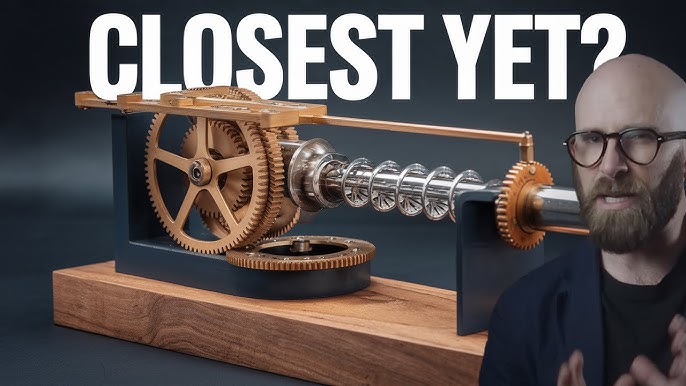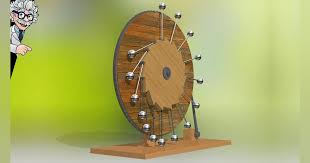Perpetual motion machine is one of the most fascinating ideas in science. It promises a machine that can work forever without stopping, producing energy endlessly. Imagine a wheel that keeps spinning, a motor that never stops, or a device that can power your home without any fuel. Many inventors and scientists have tried to build a perpetual motion machine over centuries, but so far, no one has succeeded. The main reason is that it goes against the basic laws of physics. Energy cannot be created from nothing, and friction always slows things down. Still, the idea captures the imagination of people around the world. Even though it is impossible in real life, studying perpetual motion machines helps us understand energy, efficiency, and the limits of technology. It also inspires creative thinking and engineering experiments for curious minds.
The concept of a perpetual motion machine is more than just a fantasy; it is a window into the history of scientific exploration. From Leonardo da Vinci’s sketches of endless wheels to modern theoretical models, humans have always been curious about machines that never stop. In reality, the laws of thermodynamics, which govern energy and motion, prevent perpetual motion from being possible. Every machine experiences friction, air resistance, and energy loss, meaning it will eventually stop without a power source. However, understanding these machines teaches us important lessons about efficiency, renewable energy, and mechanical design. Today, the study of perpetual motion machines has shifted to practical innovations, like improving energy-saving devices and developing renewable energy systems. By learning why perpetual motion cannot exist, we also learn how to make the machines we have work better. Curiosity about perpetual motion continues to inspire inventors, scientists, and students to push the boundaries of what technology can achieve.
Table of Contents
What is a Perpetual Motion Machine?

A perpetual motion machine is a device that can keep moving forever without any external energy input. People have imagined different types of perpetual motion machines over the years. Some are simple wheels that spin endlessly, while others are complex gears or levers that supposedly produce more energy than they consume. The key idea is that once started, the machine would never stop. It would generate unlimited energy without fuel or batteries. Scientists classify these machines into two main types:
- Perpetual Motion Machine of the First Kind: This type would create energy from nothing, breaking the first law of thermodynamics.
- Perpetual Motion Machine of the Second Kind: This type would supposedly convert heat into work without losing any energy, breaking the second law of thermodynamics.
Both types are impossible according to modern science, but the imagination behind them has led to creative engineering experiments.
The History of Perpetual Motion Machines
Perpetual motion machines have a long history that goes back hundreds of years. Inventors in the 13th century tried to create self-moving wheels and mechanical devices. Leonardo da Vinci studied such machines and concluded that they could not work due to friction and gravity. In the 18th and 19th centuries, more inventors attempted to build devices that would spin forever. Some were small toys, while others were serious mechanical inventions. Although none worked, these attempts showed human curiosity and creativity. The search for perpetual motion helped scientists learn more about energy, motion, and the laws of physics. Today, these historical attempts are often studied in engineering and science classes as lessons on what is physically possible and what is not.
Why a Perpetual Motion Machine is Impossible
Perpetual motion machines are impossible because they violate the laws of thermodynamics. The first law of thermodynamics says that energy cannot be created or destroyed. This means a machine cannot generate energy out of nothing. The second law of thermodynamics states that every energy transfer has some loss, often as heat or friction. Even if a machine were perfectly designed, it would eventually stop due to these energy losses. This is why no perpetual motion machine has ever worked. While it is fun to imagine endless energy, reality is clear: all machines require energy input to keep running. Understanding why perpetual motion is impossible helps scientists and engineers design more efficient devices instead of chasing a dream that cannot exist.
Famous Attempts at Building Perpetual Motion Machines
Many inventors have tried to build perpetual motion machines throughout history. Some famous examples include:
- Bhaskara’s Wheel (12th Century): A wheel designed in India that was supposed to spin forever using weights.
- Overbalanced Wheels (16th-17th Century Europe): Wheels with unevenly distributed weights that claimed to generate continuous motion.
- Modern Theoretical Designs: Some inventors use magnets or clever gears to try to achieve perpetual motion, but none succeed.
These attempts often fail due to friction, air resistance, or energy loss. Even though they don’t work, they inspire creativity and encourage learning about physics and engineering principles.
Lessons from Perpetual Motion Machines
Even if perpetual motion machines cannot exist, they teach us important lessons. Engineers learn how friction, energy loss, and efficiency affect machines. Scientists understand better how energy flows in systems. These lessons help improve engines, motors, and renewable energy devices. For example, studying why perpetual motion fails helps design wind turbines, solar panels, and energy-saving devices that work efficiently. Young inventors and students can also use the concept to learn mechanical skills and problem-solving. The study of impossible machines encourages curiosity, critical thinking, and creativity, which are valuable skills in any scientific or engineering field.
How Perpetual Motion Inspires Renewable Energy Innovations
The dream of a perpetual motion machine has inspired innovations in renewable energy. While we cannot create endless energy from nothing, we can harness natural energy sources like the sun, wind, and water. Wind turbines and solar panels do not break physics, but they follow the idea of “machines that keep going” by using natural, replenishable energy. Engineers focus on improving efficiency, reducing energy loss, and creating sustainable systems. In this way, the inspiration behind perpetual motion machines continues to shape modern technology, helping humans move closer to cleaner, more reliable energy solutions.
Understanding the Science Behind Perpetual Motion Machines
To understand why a perpetual motion machine cannot exist, it helps to study basic physics. Friction is the force that slows moving objects, and energy always spreads out into heat or sound. Even a perfectly balanced machine will lose energy over time. The study of these machines also introduces concepts like mechanical advantage, energy conservation, and thermodynamics. Students and inventors can learn how to make machines work better, even if they cannot make them last forever. In short, perpetual motion machines are a gateway to understanding how the real world of energy and motion operates.
Perpetual Motion Machines in Popular Culture
Perpetual motion machines often appear in books, cartoons, and movies. They are symbols of endless energy, clever inventions, and impossible dreams. Popular culture portrays them as magical devices or tools for genius inventors. While they are fictional in reality, these machines inspire curiosity and wonder. They encourage people to ask questions about energy, motion, and the limits of technology. This curiosity drives innovation and learning, making the idea of perpetual motion valuable beyond its physical impossibility.
Conclusion
Perpetual motion machines may never exist in the real world, but they continue to inspire curiosity, creativity, and scientific learning. Understanding why they are impossible teaches important lessons about energy, motion, and efficiency. From historical attempts to modern engineering lessons, perpetual motion machines remain a symbol of human imagination and the drive to innovate. While we cannot create endless energy, the dream motivates us to design better, more efficient machines and explore renewable energy solutions.
FAQs
Q1: Can a perpetual motion machine ever be built?
No, it is impossible due to the laws of thermodynamics. Energy losses from friction and heat prevent any machine from running forever without energy input.
Q2: Who first tried to invent a perpetual motion machine?
Attempts date back to the 12th century with inventors like Bhaskara, and many others in Europe later tried to create overbalanced wheels.
Q3: What are the types of perpetual motion machines?
There are two main types:
- First kind: Violates the first law of thermodynamics (creates energy from nothing).
- Second kind: Violates the second law of thermodynamics (converts heat to work without energy loss).
Q4: Why is studying perpetual motion machines useful?
It helps us understand energy, efficiency, friction, and mechanical design, which can improve real-world machines and renewable energy devices.
Q5: Do perpetual motion machines exist in real life?
No, all real machines eventually stop because of energy losses, but the idea continues to inspire inventions and scientific exploration.


